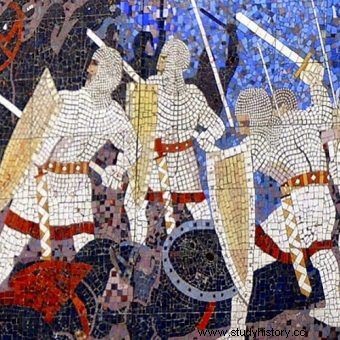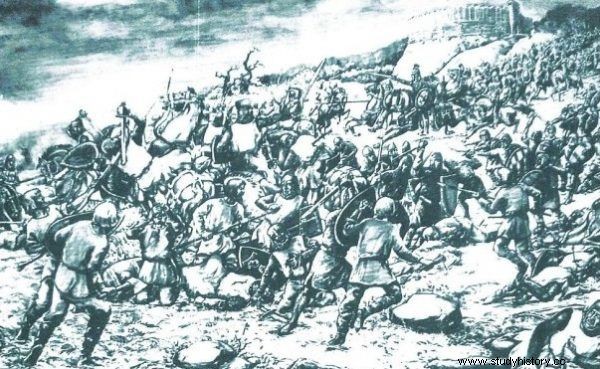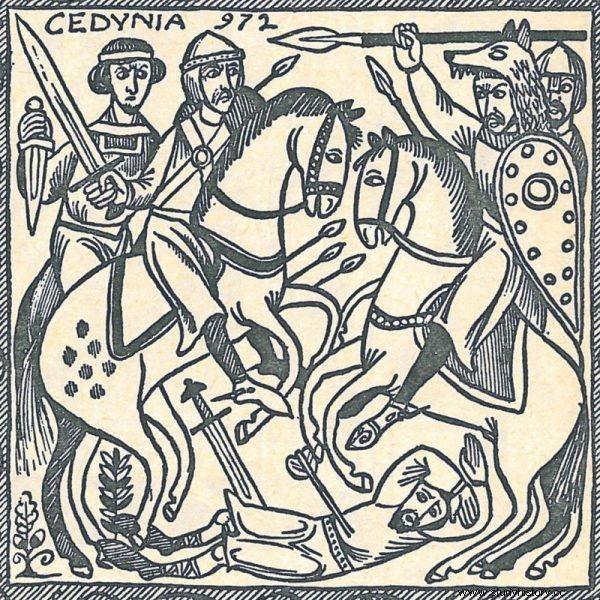Contrary to what textbooks teach us, no chronicle mentions a word about the "battle of Cedynia". What then happened in 972? Or rather:where did it happen?
I wrote about the famous clash between the Polish prince Mieszko and the troops of the German margrave Hodon in another text (click HERE to read it) . One point, however, deserves a separate treatment. Where was the skirmish really played? And why is the answer not at all obvious?
Inaccurate translation
According to the commonly used translation of the chronicle of Thietmar - a German bishop and son of one of the participants in the battle - the battle took place "in a place called Cedynia". In fact, Thietmar did not write about the village, but only about the place ( locum ). And he did not use the name Cedynia, but the Latin name Cidini .

A fragment of a mosaic on the so-called Czcibora Mountain under the present day Cedynia
It is not known whether he meant a fortress, a settlement or even a forest or a ford. Today, the battle is associated with Cedynia, located on the Polish-German border. Behind this identification, however, there are mainly ... political arguments.
There is no shortage of alternatives
The location of the clash began at the beginning of the 19th century. Even then, today's Cedinia was considered, but it was not the only, or even the strongest candidate.
In 1839, the German medievalist Friedrich Wilhelm Barthold stated that he would gladly locate the battle of 972 there, "if this town were not so far to the north [and] if there were no old Slavic villages in this area with names such as Zithen or Sithen. ”.

Bitwa pod Cedynia in the drawing by L. Piesicki
Indeed, if the battle had been fought at the present day Cedynia, Hodon would have had to "venture far north." The magnate ruled over Lusatia. Reaching Cedynia would require marching through one of the rival margraves and circumventing the borders of Mieszko's territory in a wide, over two hundred kilometer arc. Maybe it was done, but it seems more likely that Hodon took the shorter route, leading from his domains straight to the lands of the Piasts.
Barthold was also right to say that the name Cidini is so uncharacteristic that after a thousand years it can be associated with dozens of towns. And the same number probably existed once, but has long since disappeared into the mists of history.
Strange understatement
Other researchers, in turn, drew attention to the lack of mention of a basic element of the landscape that would have to be struck by German soldiers if the fight took place on the present Polish-German border.
As one historian emphasized:"It is hard to believe that Thietmar wrote down the name of some little telling town, but omitted its location on the Oder, which spreads several kilometers in this place."
Political name
Importantly, the present Cedynia itself in the nineteenth century (and in the previous centuries) was not Cedynia at all. The town was then located in Germany and was called Zehden. Only after World War II, with full deliberation and for propaganda purposes, the captured border center was renamed to remind of the earlier confrontation with the same enemy. It was not an immediate decision. Initially, Cedynia was Cednem, then Cedzyna, and for a moment even ... Szczerbiec. The final name was not introduced until 1946.

The Battle of Cedynia was filled with a whole series of myths. Above, an illustration from the book “Polskie triumfy”.
For laymen, the name of the city became a perfect proof of its connection with the famous battle. However, according to current knowledge, this is a completely clunky reference. Already in 1928, Aleksander Brückner rejected the name "Cedynia" as a misreading of the original name, which Thietmar was not very skillfully trying to write in Latin.
Also a contemporary researcher and an authority on the history of Pomerania, Professor Jan Maria Piskorski, makes it clear:no matter where the historical town of Cidini was located, it could not be any Cedynia. It would have to be:"Sidzina or Siedina or Szczytno or Sitno, because this is the only way to read the Cidini notation."
Find out more:
- Filipowiak W., Cedynia in the times of Mieszko I , Poznań Publishing House, Poznań 1966.
- Janicki K., Iron ladies. The Women Who Built Poland , Znak Horyzont, Krakow 2015.
- Labuda G., Studies on the beginnings of the Polish state , vol. I, Scientific Publishers of the University of Adama Mickiewicza, Poznań 1987.
- Migdalski P., The meaning and location of the Battle of Cidini in the light of historiography [in:] Civitas Schinesghe. Mieszko I and the beginnings of the Polish state , edited by Jan Maria Piskorski, Poznań Society of Friends of Sciences, Poznań – Gniezno 2004.
- Piskorski J.M., Tribal Pomerania . History - Archeology - Linguistics , Sorus, Poznań – Szczecin 2002.
- Rochala P., Cedynia 972 , Bellona, Warsaw 2002.
- Strzelczyk J., Mieszko the First , Abos Publishing House, Poznań 1992.
- Strzelczyk J., Otto the Great , Poznań Publishing House, Poznań 2018.
